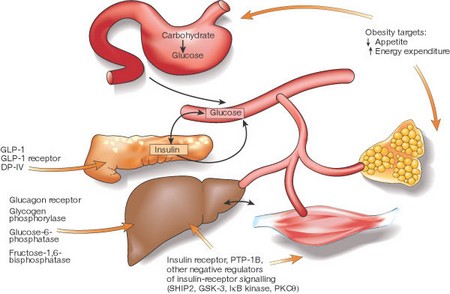Carbohydrates, which are composed of a variety of sugar molecules, are known as sugars and starches and are the body’s major source of energy. In addition, carbohydrates build and repair body tissues and regulate most body functions. Without them, you would die. There are two major types: simple and complex. Simple carbohydrates are sugars such as lactose (found in milk), glucose, fructose (found in fruits and vegetables), and sucrose (cane or beet sugar). Anything that tastes sweet contains one or more types of sugar.
Complex carbohydrates, so named because they are chemically more complicated than simple sugars, are found in starches such as bread, pasta, and rice, and some vegetables such as beans, potatoes, and corn. Fiber is a complex carbohydrate as well.

Both simple and complex carbohydrates are broken down by the body into glucose, which is the substance you measure when you test your blood. Simple and complex carbohydrates are broken down at the same rate, and they both provide four calories per gram. However, different foods produce differing amounts of glucose. Two major factors influence how high your blood glucose will go after eating: the amount of carbohydrate per serving and the speed with which the carbohydrate is converted into glucose. The latter depends on how big the servings of food are, whether it is cooked (digested faster than raw), and how much liquid the food contains (the more liquid, the faster it is digested). In addition, if you eat carbohydrates in combination with other nutrients, the carbohydrates are digested more slowly. This is why it is not a good idea to eat a candy bar as an emergency treatment for hypoglycemia; the fat from chocolate and fiber from nuts slow down the digestion process.
Carbohydrates and sugars elevate blood glucose faster than any other nutrient because carbohydrates are digested rapidly and become glucose quickly. If you don’t have enough insulin in your bloodstream to counteract a sugar surge, your blood glucose could rise abnormally. However, this does not mean that you can never eat sugar. First of all, it would be impossible because sugar is an inherent part of so many foods, and second, eating some carbohydrate and sugar is an essential part of a healthy diet.
Ever since the American Diabetes Association relaxed its food guidelines for diabetics, carbohydrate counting has become popular. The ADA noted that there was no scientific evidence that supported the restriction of foods containing sugar. That is, the effect of carbohydrates is the same on blood glucose regardless of the source. So ten grams of carbohydrate from spaghetti will act the same in your body as ten grams of carbohydrate from a piece of cake. This is good news indeed.
However, it doesn’t mean that you can go out and stuff yourself with sugar. You still have to count total carbohydrates, but it makes meal planning a good deal easier, and it allows for an occasional gooey dessert.
Your dietician or other health care provider will determine, based on your blood glucose level, medication, and exercise level, how many grams of carbohydrates you can eat in a day. You decide in what form you will consume that total—within reason. For example, you should not use up your entire carbohydrate allotment for one meal in the form of sugar, but if you are in a situation where you want to join others in eating a significant dessert (a birthday party or other social gathering), you won’t fall into an immediate diabetic coma, nor do you need to feel as if you have totally messed up your food plan. In such an instance, however, if you are a Type I diabetic, check your blood sugar immediately afterward.
There are other reasons for controlling the amount of sugary food you eat. Most of the time, they are lacking in other nutrients and provide what has become known as “empty calories.” Portion size of high-sugar food is also smaller than low-sugar foods. For instance, you can eat an entire cup of sugar-free yogurt for the same carbohydrate “price” of a third of a cup of regular fruited yogurt.